FREQUENTLY ASKED QUESTIONS
FREQUENTLY ASKED QUESTIONS

- DO YOU BUILD CUSTOM TANK SIZES?Open or CloseYes. In addition to the sizes and configurations listed throughout our product line pages and literature, we offer custom lengths and diameters. Length is available in one foot increments. Diameter is available in two-inch increments. For help determine proper tank dimensions for your unit, visit our Tank Size Wizard.
- DO YOU BUY USED VACUUM PUMPS?Open or CloseYes. We will consider buying your used pump. You will need to ship the pump to us prior to receiving any credit or payment. We will analyze the pump and determine its value. Pumps with cracked housings or bent rotors are generally not worth more than basic scrap value. We will give you fair market value for pumps that can be rebuilt. Pictures and inquiries can be sent to info@lmtmfg.com.
- DO YOU BUY USED TANKS?Open or CloseFor the most part, no. However, there are always exceptions so don't hesitate to ask. Pictures and inquiries can be sent to info@lmtmfg.com.
- WILL YOU REFURBISH MY OLD TANK?Open or CloseYes. For an estimate, please send pictures to info@lmtmfg.com.
- DO YOU STILL BUILD LIQUID WASTE MANURE SPREADERS?Open or CloseNo. LMT no longer manufactures complete units for agricultural use. We do often build new tanks and install and rebuild pumps. We also have a wide variety of hose, fittings, etc. as replacement parts of LMT, Better-Bilt, and other brands of liquid manure spreaders.
- HOW DO I SET MY VACUUM RELIEF VALVE?Open or CloseA) Remove cover (1) from the adjusting bell (2) by using the point of a screwdriver in the special slot.
B) Loosen the stop set nut (3) while firmly holding the adjusting bell (2).
C) Regulate the pressure on the spring by turning the adjusting bell (2). Turn CLOCKWISE toINCREASE the pressure and turn COUNTER-CLOCKWISE to REDUCE it. During this operation it is necessary to avoid the rotation of the stem acting with a screwdriver in the special incision that you find in the stem.
D) As soon as the regulation is completed, screw the stop set nut again (3) by firmly holding the adjusting bell (2). The set nut must be screwed with a screwing torque of 10 nm (at last). Insert the cover (1) with pressure on the adjusting bell (2).
E) Put the setting-seal by tying with a wire (4) the cover (1) and the adjusting bell (2), and apply finally the plumbing.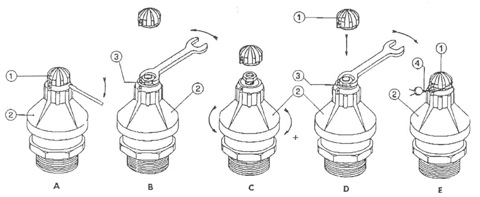
- HOW DO I SET MY PRESSURE RELIEF VALVE?Open or Close(1) Loosen the set screw (ref. # 1) using a hex wrench. Loosen it sufficiently to the allow the upper ring (ref. # 3) to rotate.
(2) Adjust the setting pressure by:
A - Increase (clockwise rotation) or
B - Decrease (counter-clockwise rotation)
(3) When you reach the desired pressure setting, verify that the arrow on the stem (ref. # 2) lines up to the set screw (ref. # 1). On the contrary it is necessary to turn the upper ring until you reach the correct position. Finally, tighten the set screw (ref. # 1).
NOTE: Verify that the stem is loose but can not turn completely. It must be able to move vertically. Test this by pulling on the ring and verifying vertical movement.
USE ONLY Metaltecnica replacement parts.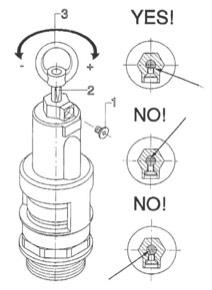
- WHAT IS THE DIFFERENCE BETWEEN VANE PUMPS & "ROOTS" BLOWERS?Open or CloseRotary vane pumps use circular rotors that rotate inside of a larger circular cavity. The centers of these two circles are offset, causing eccentricity. Vanes are allowed to slide into and out of the rotor and seal on all edges, creating vane chambers that move the air. On the intake side of the pump, the vane chambers are increasing in volume. These increasing volume vane chambers are filled with air forced in by differential inlet pressure. Usually this inlet pressure is nothing more than pressure from the atmosphere. On the discharge side of the pump, the vane chambers are decreasing in volume, forcing air out of the pump. The action of the vane drives out the same volume of air with each rotation.
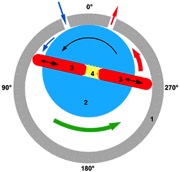 Key:
Key:
1. pump housing
2. rotor
3. vanes
4. spring (note that most pumps used in the septic industry - PB Pumps, Masport, Jurop, etc. - do not use a spring. They us a solid rotor and rely on centrifigul force to slide the vanes into contact with the pump housing."Roots" blowers are positive displacement lobe pumps which operate by pumping fluids with a pair of meshing lobes not unlike a set of stretched gears. Air is trapped in pockets surrounding the lobes and carried from the intake side to the exhaust. It is frequently used as supercharger in engines, where it is driven directly from the engine's crankshaft via a belt or, in a two-stroke diesel engine, by spur gears.It is named for the brothers Philander and Francis Marion Roots of Connersville, Indiana, who first patented the basic design in 1860 as an air pump for use in blast furnaces and other industrial applications. In 1900, Gottlieb Daimler included a Roots-style supercharger in a patented engine design, making the Roots-type supercharger the oldest of the various designs now available.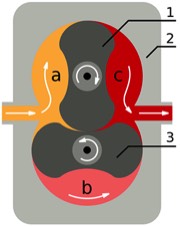 Key:
Key:
1. Rotary vane 1
2. Pump body
3. Rotary vane 2
a. Intake - this connects to your vacuum tank
b. Pumping
c. Forced air - exhaust on vacuum system - HOW DO I MAINTAIN MY ROTARY VANE PUMP?Open or CloseTo eliminate buildup of foreign material on the inner working surfaces of the pump and for smooth operation and maximum pump life it is recommended that the pump be flushed with diesel fuel every three moths or immediately after any foreign material has been drawn into the pump.
To flush the pump, slowly pour 4 ounces of diesel fuel into the intake port of the pump while slowly rotating the pump, preferably by hand, until most of the liquid is purged out of the pump.
Following this operation, 4 ounces of clean oil should be poured into the pump and the same procedure followed. - HOW DO I STORE MY PUMP IF IT IS NOT IN USE?Open or CloseIf the pump is likely to remain idle for an extended period of time it is advisable to follow the flushing instructions (See above under "How do I maintain my rotary vane pump?") prior to storage to prevent rusting of the internal parts. In storage situations oil should also be poured into the bearing lubrication ports to protect the bearing surfaces. Cover the pump intake and output ports to prevent dust and dirt from entering the pump.
- WHY CAN'T I JUST USE A SHOP VAC?Open or CloseWhile a ShopVac style system might be rated at a higher CFM than a rotary vane vacuum pump, a ShopVac cannot reach the same level of vacuum.
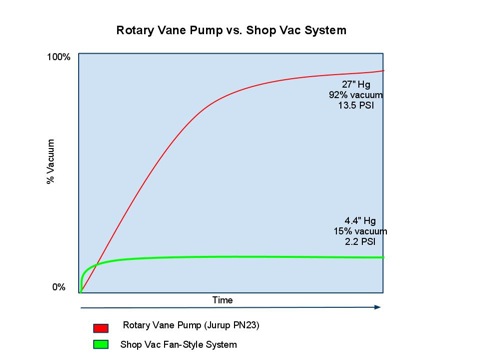
- WHAT IS THE DIFFERENCE BETWEEN STANDARD CFM AND ACTUAL CFM?Open or CloseSCFM - Standard Cubic Feet per Minute
It is common to rate the compressed air consumption in Standard Cubic Feet per Minute - SCFM.
The SCFM - Standard Cubic Feet per Minute - determines the weight of air to fixed or "Standard" conditions. There are several definitions of SCFM. The most common used in the United States is with "sea-level" properties:
• 14.696 Pounds per Square Inch (psia)
• 60 Degrees Fahrenheit (oF) (520oR)
• 0% Relative Humidity (RH)
Europeans normally use one ata and 0 oC as SCFM.ACFM - Actual Cubic Feet per Minute
Unfortunately, real life "actual conditions" are seldom "standard conditions". When
• pressure is applied a volume of air - it gets smaller
• vacuum is applied to a volume of air - it expand
Actual air volume flow is often termed ACFM - Actual Cubic Feet per Minute.
Actual Cubic Feet per Minute - ACFM, depends on the
• pressure
• temperature
• humidity
of the actual air.The conversion from SCFM to ACFM can be
expressed as
ACFM = SCFM [Pstd / (Pact - Psat Φ)](Tact / Tstd) (1)
where
ACFM = Actual Cubic Feet per Minute
SCFM = Standard Cubic Feet per Minute
Pstd = Standard absolute air pressure (psia)
Pact = absolute pressure at the actual level (psia)
Psat = Saturation pressure at the actual temperature (psi)
Φ = Actual relative humidity
Tact = Actual ambient air temperature (oR)
Tstd = Standard temperature (oR)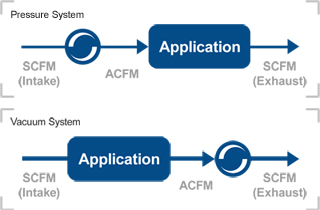
- WHAT TYPE OF OIL SHOULD I USE TO LUBRICATE MY PUMP?Open or CloseWe recommend our VAXTEEL ISO 68 Grade Vacuum Pump Oil.
- HOW DOES A VACUUM TANK WORK?Open or CloseVisit our Vacuum Tank 101 page for a graphical overview of an industrial vacuum system. Watch this short video for the very basics:
- Enter Title HereOpen or Close
For questions not listed, please send to: info@lmtmfg.com
